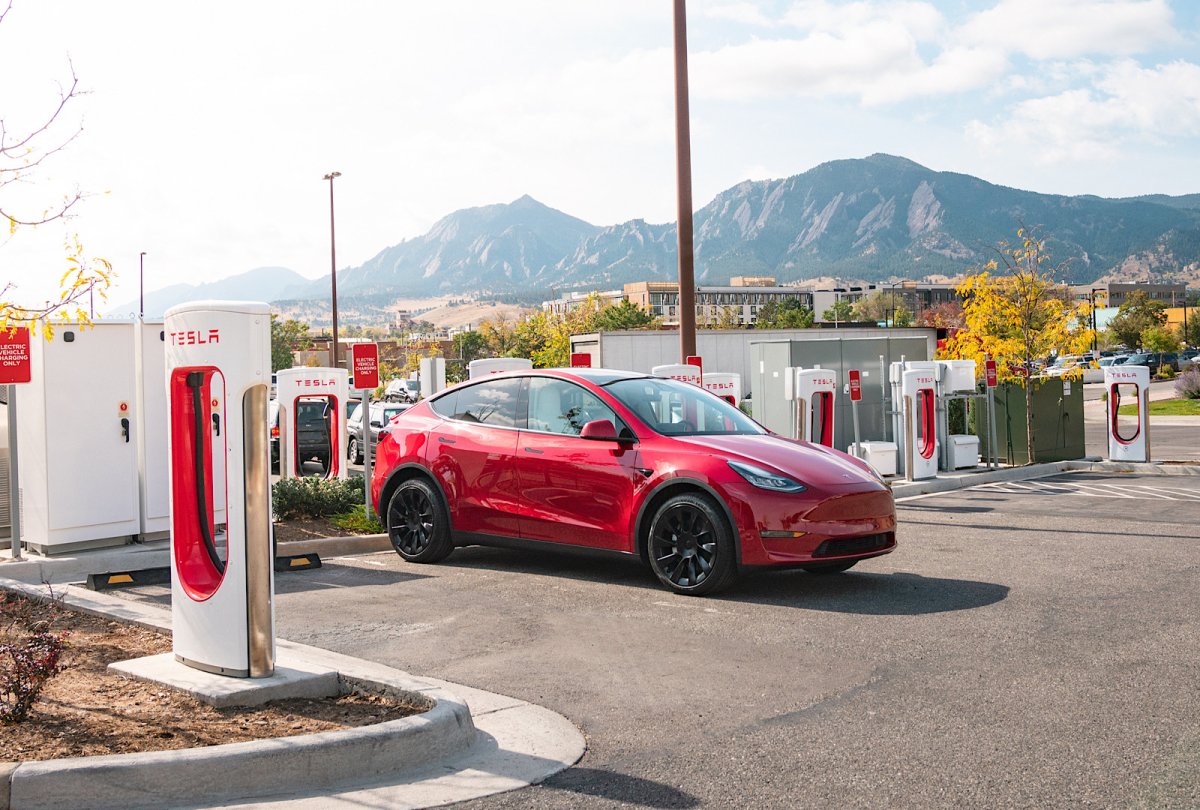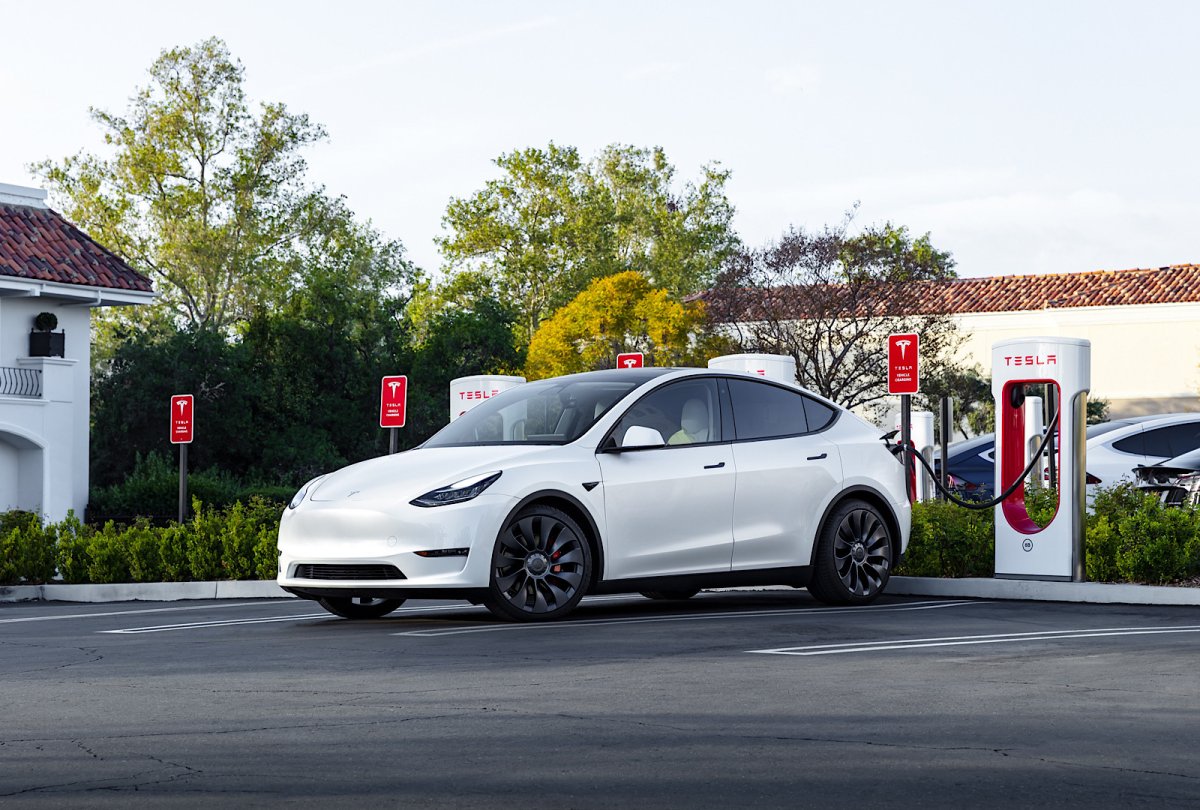Elon Musk's greatest Tesla successes may not be vehicles. The Tesla CEO's lasting impact on the auto industry, and the greater world at large, is public acceptance of battery-electric vehicles (BEVs) as a viable mode of transportation in modern times and the build out of the Tesla Supercharger network, experts say.
"I think up until the last five to six years, you could draw a lot of parallels between Steve Jobs and Elon Musk, when it comes to developing a brand, making it cool, and keeping people interested. Jobs didn't invent the digital music player, but he made the iPod. Musk didn't invent the electric car, but he made Teslas. It was very Jobs-onian of him," Chad Kirchner, vice president of content at EV Pulse, told Newsweek.
At the turn of the 20th Century, gasoline-powered cars were going head-to-head with those powered by electricity to see which fuel would become the people's choice. Today, a similar battle is happening, though this time with more government influence on the outcome, and on a far larger scale.
The Environmental Protection Agency (EPA) recently spelled out a list of targets that it hopes to reach as the auto industry approaches a carbon neutral future. It is predicting that 67 percent of vehicles will be electrified in the near future, a lofty estimate of where vehicle sales could end up should a number of alternative fuel factors play out.
The 758-page proposal presumes that automakers and consumers will fully abandon any hybrid vehicle powertrain solution in favor of BEVs ostensibly because recently passed legislation, including tax credits, would make the cost of owning an electric vehicle and ease of charging a model more palatable for Americans, Stephanie Brinley, associate director of research and analysis at S&P Global explained to Newsweek.

EPA estimates based on fuel savings over the life of a vehicle assumes that the first owner of a vehicle drives it for eight years. Brinley says that ownership cycles tend to favor faster replacement than that.
"There are a number of underlying assumptions in the EPA saying its rules could lead to a 67 percent electric vehicle share of light-duty vehicle sales. The proposed rule only dictates the vehicle emissions, not the technology used to get there. There remains potential for other solutions to contribute to reaching the emissions targets that could change the EPA's estimates for a potential sales mix," Brinley said.
"In addition, there are consumer electric vehicle education and adoption issues, manufacturing and supply chain development challenges, and infrastructure issues which will need to be resolved to get to the EPA's scenario. Massive amounts of money, research, technology and innovation are being applied to address each of those issues; it would be unwise to presume the EPA's estimate cannot be reached. But it is also wise to recognize there are challenges to getting there."
Tesla has had four major successes aside from bringing cars to market: Supercharger network location, uptime of chargers, plug-and-charge and cost of charging. Industry analysts point to these as benchmarks that the U.S. federal government should take into consideration as it works with companies to improve EV charging infrastructure and promote the adoption of EVs.
Supercharger network location
Tesla's Supercharger network wasn't built on the idea that electric vehicle owners needed a fast charging source for their daily lives. The company designed it based on the premise that owners would charge at home then utilize Superchargers as they moved between cities. The company built their installations, often six, eight or 12 chargers in one spot, between towns.

"If you looked at a map of Superchargers, for the longest time, the oldest stations were the busiest because that's where the traffic was. Elon correctly predicted that behavior," Kirchner said.
This is still a relatively novel idea. Most Electrify America, EVgo, and ChargePoint chargers are based within cities and at destinations as opposed to being between them. Only recently have those companies created cross-country networks, but even then, there's stretches of road without charging that cause many EV owners to need to drive conservatively to reach their next destination after achieving the desirable 80 percent battery state of charge. There are frequently less of these branded chargers per location than at Supercharger sites.
Affluent early EV adopters, who were often White, highly educated and owned their own home, were better financially positioned to install at-home charging systems than lower-income buyers that are set to come along as more budget-friendly EVs begin to be sold en masse.
The U.S. federal government intends to work with companies to further build out charging infrastructure, giving Americans more options on where they charge as part of Inflation Reduction Act and Bipartisan Infrastructure Law spending, which will see $7.5 billion allocated toward those investments.

Today, more than 130,000 public EV chargers are installed in the U.S. The administration's goal is to drive that number to 500,000.
"It's extremely important for the federal government to ensure that charging stations are being put where people are actually going to use them," Kirchner said.
Supercharger plug-and-charge technology
While some automakers have recently adopted plug-and-charge technology in their vehicles, Tesla was doing this long before it was popular, and their process remains simple to use. To activate a charging session at a Supercharger, Tesla drivers simply need to pull up, plug in and sit back as the charging session begins.
Ford's Plug & Charge (the company's branded plug-and-charge solution) is most similar to Tesla's. In a Ford Mustang Mach-E, F-150 Lightning or E-Transit, a driver must first be connected to the FordPass Connect app and have activated their BlueOval Charge Network subscription. Then they have to find a charger that is both BlueOval Charge Network and Plug & Charge compatible, which is possible via the app. Upon arrival, the customer simply pulls up and plugs in, activating the session.

If a charger isn't Plug & Charge compatible, but has a plug whose end complements the charging port of a Ford EV, it may require other steps, including downloading a new app and activating payment information, before a charging session can begin, adding minutes to a stop.
In other makers' EVs, the process often requires the download of several charger company branded apps, and a multi-step process that includes long connectivity times, to begin a charge. Some charging stations allow for direct credit card payment, but like the chargers themselves, credit card readers aren't always operable.
"The success of Tesla's Supercharger network can be distilled down to two things: reliability and ease of use, both of which are attributes that so far seem to be eluding other fast charging providers," Ed Kim, president and chief analyst of AutoPacific told Newsweek.
"Installing reliable and easy-to-use public fast chargers in safe, high visibility locations is critical, and until non-Tesla charging infrastructure can meet the standards set by Tesla's charging network, Tesla will likely retain its massive market share advantage over its competition."
Supercharger charging costs
Fueling up an EV with electrons is a completely different experience than filling up a tank with gasoline. Calculating the cost of a charging session isn't like looking at a sign featuring $3.00-per-gallon 87 octane and paying $36 to fill up with 12 gallons of gas.

For most of the Supercharger network's existence, charging a Tesla while on-the-go was complementary with purchase. Today, that has changed, though some models still receive the benefit. In the early days of electric vehicle adoption, not complicating the ownership experience with paying for charging (which is traditionally dependent on electricity flow rate), helped with overall EV satisfaction.
Today, the cost of charging at a non-Supercharger station varies greatly and is dependent on a variety of factors including time of day, location of the charger, charger owner added costs, and type of charger. Some charger owners add surcharges based on the session or time spent charging, in addition to the cost per kilowatt.
Most BEVs currently come with free charging on certain networks for a limited time. However, if an owner chooses to charge outside that network, or at home, they are still subject to the cost of charging.
Supercharger uptime
In February, the White House announced that the Federal Highway Administration (FHWA) has new standards that will make an EV charging station network that is, "as easy as filling up at a gas station".
The new standards are designed to ensure that charging is a predictable and reliable experience, chargers are operational, finding a charger is easy, paying for charging does not require multiple apps and logins, and making plug-and-charge capability more widely available.
Despite these new standards and the FHWA taking final rule action to initiate them in February, there are no ramifications for not adhering to the rule spelled out.
"Non-Tesla entities benefiting from IRA money to install more public charging infrastructure need to take significant steps to overcome those challenges because the mainstream consumers who need to be convinced to go electric won't be forgiving of chargers that are unreliable or difficult to use," Kim said.
Superchargers are noted for their uptime while Electrify America, EVgo and ChargePoint are frequently recognized by vocal social media users for their downtime.
"People who follow the EV transition closely worry a lot about poor reliability and unpredictable uptime at non-Tesla public charging networks," said John Voelcker, a contibuting editor at Car and Driver magazine who has covered EVs for 15 years.
The lack of common charging initiation, though inconvenient, isn't the biggest problem, Voeckler said, "It's the unpredictability and questionable reliability of those private stations--as demonstrated by the thousands of frustrated howls by EV drivers who may have arrived at a station late at night only to find that of four pedestals, one or two are completely dark, one is spooling Windows code on a frozen screen, and the fourth one has a non-working credit-card reader.

"We wouldn't accept that from gas stations, would we? The problem is that today, all the incentives (legal and financial) are to get the stations in the ground to take proud opening-day photos with local politicians. There are almost no incentives to keep them working properly.
"That contrasts to the seamless and now almost ubiquitous Tesla Supercharger network. You can now drive a Tesla pretty much anywhere in the lower 48 states, with the car routing drivers among charging locations and even telling them how long to stay to minimize time off the road. Reliability appears to be close to 100 percent, and with large charging sites built with future sales in mind, Tesla drivers enjoy almost friction-free charging during road trips."
Uncommon Knowledge
Newsweek is committed to challenging conventional wisdom and finding connections in the search for common ground.
Newsweek is committed to challenging conventional wisdom and finding connections in the search for common ground.
About the writer
Eileen Falkenberg-Hull leads the Autos team at Newsweek. She has written extensively about the auto industry for U.S. News & ... Read more
To read how Newsweek uses AI as a newsroom tool, Click here.





